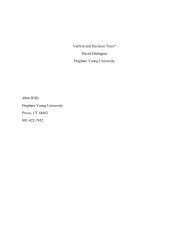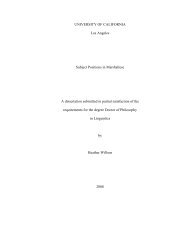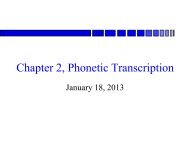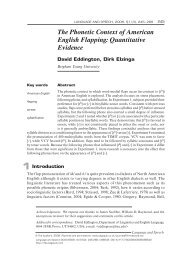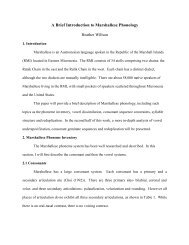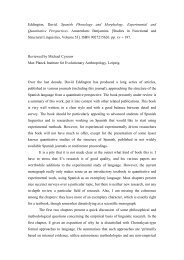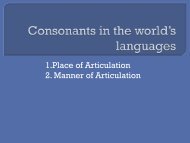Place and Manner of Articulation - Department of Linguistics and ...
Place and Manner of Articulation - Department of Linguistics and ...
Place and Manner of Articulation - Department of Linguistics and ...
You also want an ePaper? Increase the reach of your titles
YUMPU automatically turns print PDFs into web optimized ePapers that Google loves.
1.<strong>Place</strong> <strong>of</strong> <strong>Articulation</strong><br />
2. <strong>Manner</strong> <strong>of</strong> <strong>Articulation</strong>
Definition: place <strong>of</strong> articulation refers to<br />
(1) the part <strong>of</strong> the upper surface <strong>of</strong> the<br />
vocal tract<br />
(2) the articulator on the lower surface<br />
(usually the tongue)
1. Lingua-labials (t̼ )<br />
2. Labial affricate (pf)<br />
3. Labiovelars k͡p<br />
4. Alveolar affricates (ts)<br />
5. Alveolo-palatals (ɕ, ʑ)<br />
6. Emphatics (sˤ)
Upper surface:<br />
Lower surface:<br />
English has alveolar stops [t d n]<br />
It is also possible to have alveolar affricates<br />
German <strong>and</strong> Polish has a voiceless alveolar affricate<br />
[ts]<br />
Canadian French <strong>and</strong> Greek have both voiced <strong>and</strong><br />
voiceless alveolar affricates [ts] <strong>and</strong> [dz]; e.g. (GR)<br />
[tsai] tea, [dzaci] fireplace<br />
--This is sometimes called assibilation when a stop<br />
becomes a fricative or affricate
Baker & Smith, 2010
Why learning French first is better than<br />
learning German first<br />
1<br />
0.75<br />
0.5<br />
0.25<br />
0<br />
E/i/-F/i/ E/i/-G/i/ E/i/-F/y/ E/i/-G/y/ E/u/-F/u/ E/u/-G/u/ E/u/-F/y/ E/u/-G/y/<br />
/i/-/i/ /i/-/y/ /u/-/u/ /u/-/y/
Upper Surface:<br />
Lower Surface:<br />
Retr<strong>of</strong>lex sounds are produced with the tip <strong>of</strong> the<br />
tongue curled up <strong>and</strong> back to touch the area<br />
behind the alveolar ridge
About 20% <strong>of</strong> the world’s languages have<br />
them.<br />
1. Europe: Swedish, Norwegian, Italian<br />
dialects, Russian, Polish<br />
2. Chinese, Javanese, Vietnamese<br />
3. Australian languages<br />
4. Indo-Aryan <strong>and</strong> Dravidian languages (in<br />
India <strong>and</strong> Afghanistan)<br />
5. Absent in American languages
Contrasts dental, alveolar,<br />
retr<strong>of</strong>lex stops, <strong>and</strong> also have a<br />
retracted alveolar affricate<br />
From<br />
Ladefoged,<br />
2001
M<strong>and</strong>arin<br />
Hakka<br />
Wu<br />
Japanese<br />
Korean<br />
Russian (both retr<strong>of</strong>lex <strong>and</strong> aleovo-pal.)<br />
Serbo-Croatian<br />
Abkhaz (Turkey, Russia)<br />
Ubykh (Black Sea)
http://hctv.humnet.ucla.edu/departments/linguistics/html
Hungarian palatals<br />
Gather his brain mother<br />
From Ladefoged, 2001
Gurani<br />
Icel<strong>and</strong>ic<br />
Irish<br />
Korean (doctor uisa 의사 )<br />
Tagalog (‘y’ igreiga)<br />
Spanish /g/ in between vowels is<br />
sometimes pronounced this way too
1. African languages<br />
2. Semitic languages<br />
3. American languages
Chechen
1. African languages<br />
2. Semitic languages<br />
3. North American languages
Emphatic sounds involve a primary<br />
articulation such as [t] or [s] with<br />
simultaneous retraction <strong>of</strong> the tongue –<br />
they are described as ‘uvularized’ or<br />
‘pharyngealized’<br />
Transcription: [ tˤ]<br />
Contrast: [s] [s ˤ]





